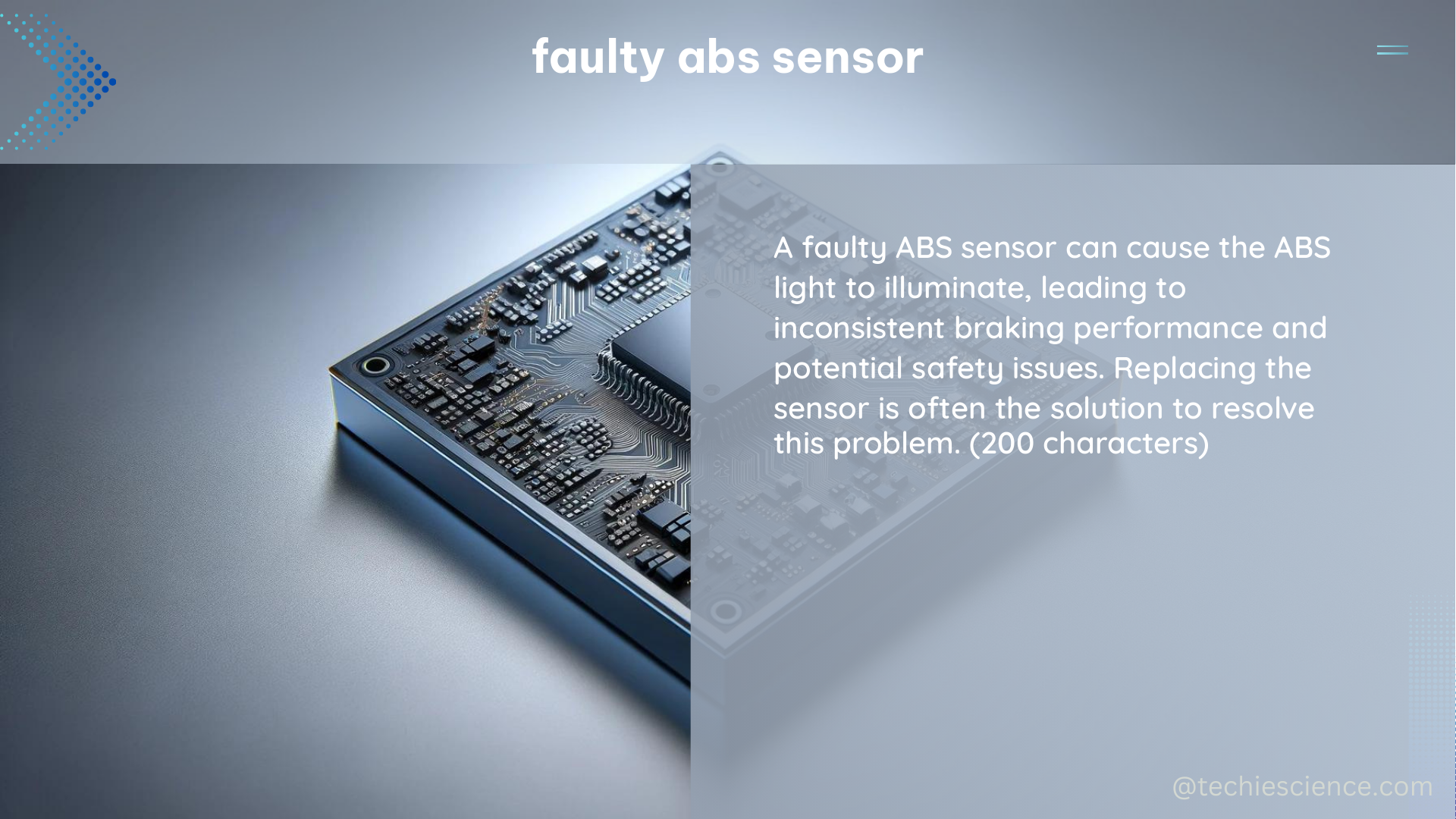A faulty ABS (Anti-lock Braking System) sensor can cause a range of issues in a vehicle’s braking system, leading to poor performance and potential safety risks. The ABS sensor is responsible for measuring the rotational speed of each wheel and transmitting this data to the ABS control unit, which then uses the information to prevent wheel lockup during hard braking, ensuring stability and control.
Technical Specifications of a Faulty ABS Sensor
A faulty ABS sensor may exhibit the following technical characteristics:
- Incorrect or No Signal:
- A faulty ABS sensor may fail to provide accurate speed measurements or may not transmit any signal at all.
- This can be due to a broken sensor cable, a loose connection, or a damaged sensor.
- Typical symptoms include the ABS warning light illuminating on the dashboard and the ABS system not functioning properly.
-
The sensor’s resistance should typically be between 800-2,000 ohms, and any reading outside this range may indicate a faulty sensor.
-
Intermittent Signal:
- A faulty ABS sensor may provide intermittent or inconsistent signals, leading to unpredictable braking performance.
- This can be caused by a weakened sensor cable, a damaged connector, or a malfunctioning sensor.
- Intermittent signals can be difficult to diagnose, as the issue may not be present during the diagnostic process.
-
Using a digital multimeter to monitor the sensor’s voltage output while driving can help identify intermittent signal issues.
-
High Resistance:
- A faulty ABS sensor may have a higher resistance than normal, which can affect the signal quality and lead to incorrect speed measurements.
- This can be due to a damaged sensor or a faulty wiring connection.
- Typical resistance values for ABS sensors range from 800 to 2,000 ohms, depending on the specific sensor and vehicle model.
-
Using a multimeter to measure the sensor’s resistance can help identify high resistance issues.
-
Inconsistent Frequency:
- A faulty ABS sensor may produce an inconsistent frequency of alternating voltage, which can affect the accuracy of speed measurements.
- This can be caused by a damaged impulse wheel, a weakened magnet, or a faulty sensor.
- The sensor’s frequency output should be consistent and within the manufacturer’s specified range, typically between 4-100 Hz.
- Using an oscilloscope or a frequency counter can help diagnose inconsistent frequency issues.
DIY for a Faulty ABS Sensor

To diagnose and fix a faulty ABS sensor, follow these steps:
- Check the Sensor Cable:
- Inspect the sensor cable for any visible damage, such as cuts, breaks, or fraying.
- Use a multimeter to check the cable’s continuity and ensure there are no breaks or shorts in the wiring.
-
Replace the cable if necessary, ensuring the new cable is properly routed and secured.
-
Check the Connector:
- Inspect the connector for any signs of corrosion, dirt, or damage.
- Clean the connector using a contact cleaner and ensure a secure connection.
-
If the connector is damaged, replace it with a new one that matches the vehicle’s specifications.
-
Check the Sensor:
- Inspect the sensor for any signs of damage, such as cracks or dents.
- Use a multimeter to test the sensor’s resistance, ensuring it falls within the recommended range.
-
If the resistance is outside the recommended range, replace the sensor with a new one that meets the vehicle manufacturer’s specifications.
-
Check the Impulse Wheel:
- Inspect the impulse wheel (also known as the tone ring or reluctor ring) for any signs of damage, such as missing teeth or excessive wear.
- The impulse wheel is responsible for generating the signal that the ABS sensor reads, so any issues with the wheel can affect the sensor’s performance.
-
Replace the impulse wheel if necessary, ensuring the new one is properly installed and aligned.
-
Test the System:
- After completing the repairs, clear any fault codes and perform a test drive to verify the ABS system’s functionality.
- Use a diagnostic tool to check for any remaining fault codes and ensure the ABS system is operating correctly.
- If the issue persists, further diagnosis may be required, such as checking the ABS control unit or other related components.
Remember, always refer to the vehicle manufacturer’s service manual for specific diagnostic procedures and replacement part specifications. Proper diagnosis and repair of a faulty ABS sensor are crucial for maintaining the vehicle’s braking performance and ensuring the safety of the driver and passengers.
References:
- AI for Science, Energy, and Security – Argonne National Laboratory: https://www.anl.gov/sites/www/files/2023-06/AI4SESReport-2023-v6.pdf
- Federal Motor Vehicle Safety Standards; V2V Communications: https://www.federalregister.gov/documents/2017/01/12/2016-31059/federal-motor-vehicle-safety-standards-v2v-communications
- F1 Score in Machine Learning Explained | Encord: https://encord.com/blog/f1-score-in-machine-learning/
- Mastering Data Cleaning & Data Preprocessing – Encord: https://encord.com/blog/data-cleaning-data-preprocessing/
- Check and change ABS and wheel speed sensors | HELLA: https://www.hella.com/techworld/us/Technical/Sensors-and-actuators/Check-change-ABS-sensor-4074/

The lambdageeks.com Core SME Team is a group of experienced subject matter experts from diverse scientific and technical fields including Physics, Chemistry, Technology,Electronics & Electrical Engineering, Automotive, Mechanical Engineering. Our team collaborates to create high-quality, well-researched articles on a wide range of science and technology topics for the lambdageeks.com website.
All Our Senior SME are having more than 7 Years of experience in the respective fields . They are either Working Industry Professionals or assocaited With different Universities. Refer Our Authors Page to get to know About our Core SMEs.